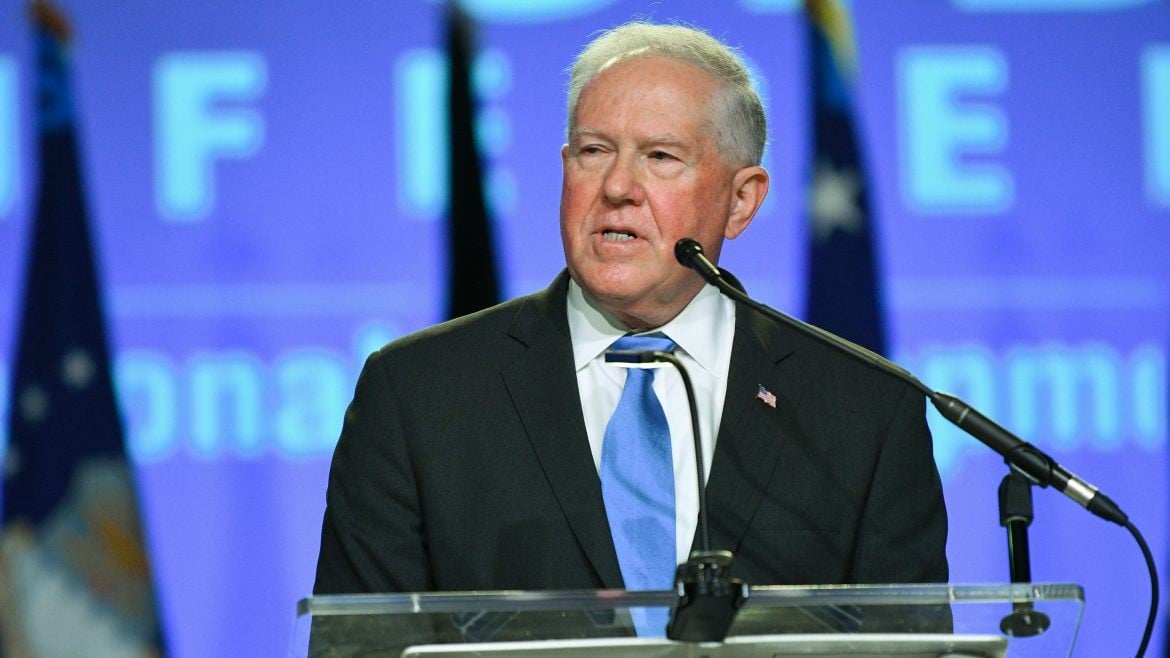
Frank Kendall, Air Force secretary, speaks at the annual Air Force Association conference in Sept. 2021. (AFA)
AFA WARFARE SYMPOSIUM — The Air Force will soon eliminate vendors currently in the running to field the service’s Collaborative Combat Aircraft (CCA), reducing the pool to two or three contractors, according to Secretary Frank Kendall.
Speaking during a roundtable with reporters at the Air & Space Forces Association’s Warfare Symposium, Kendall said today the downselect will occur “within just the next few months.” The service is planning for at least two vendors to move forward, Kendall said, adding that three could be possible if industry shares the cost.
As Breaking Defense first reported, five contractors — Boeing, General Atomics Aeronautical Systems, Lockheed Martin, Northrop Grumman and startup Anduril — are currently in the running to field the Air Force’s first CCA, a loyal wingman drone that will operate alongside manned fighters.
Kendall added that the vendors who are not eliminated will move into a development phase. After that, “we’ll be moving forward in a couple of years to downselect for production,” he said. It’s “uncertain” how many vendors could move into the production phase, he added, though “there’s a possibility that we could do more than one.”
The secretary further revealed a second CCA “increment” will quickly follow the first underway right now, echoing previous comments from officials that successive competitions will provide losing vendors opportunities for future on-ramps. The Air Force is planning to launch that increment in the FY25 budget, Kendall said, whose structure will closely mirror that of the first. The second increment will additionally try to include international partners, Kendall said.
As part of an October state visit by Australian Prime Minister Anthony Albanese, the US and Australia revealed plans to collaborate on CCA development. That announcement came on the heels of a separate speech by a Japanese official at a conference in Washington who referenced similar cooperation on manned/unmanned teaming — raising the prospect that a US-Aussie-Japanese loyal wingman drone is in the cards.
Kendall didn’t specify what nations would be involved in the second increment, saying only that it would be the US’s “closest partners.”
In a later roundtable Tuesday, Air Force acquisition chief Andrew Hunter said a “huge team of vendors” is working in parallel to develop CCA software, which is proceeding independent of progress on the increments aimed at fielding the CCA hardware.
The first increment will deliver “useful” autonomous capabilities, Hunter said, though he noted those might be more “limited” compared to what could come in the future as the technology develops. Additionally, the second increment could “potentially [have] a very different set of requirements” than the current increment, Hunter said, stressing that the process will be “iterative” with industry.
The Air Force is still operating under a continuing resolution (CR), which froze spending at fiscal 2023 levels. That constraint means the FY24 budget must be approved before the service’s CCA plans can move forward, Kendall emphasized, who has previously warned a “year” of work on CCA could be lost if the CR stretches on.








